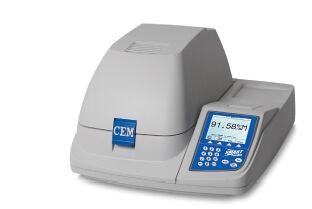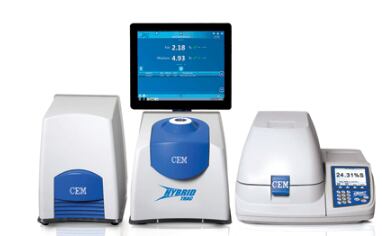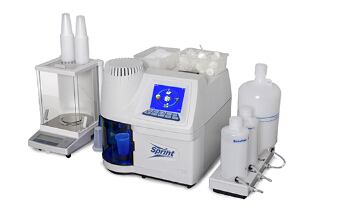The firm told FoodQualityNews.com how its microwave dryer, a machine combining microwave moisture analysis and NMR and a protein analyser could help laboratories and be used on site.
The three instruments can do direct measurement of moisture, fat and protein in a variety of food samples in minutes.
Mike Collins, CEO and president of CEM Corporation, said food testing represents a third of overall business.
“What we do is provide rapid direct methods for doing food compositional measurements that can be used in plants as well as in quality control labs that control those plants,” he said at Analytica trade show in Munich.
“The unique things about our technology are they are direct measurements so they provide primary measurements of the main food components but they are simple and fast enough to be done in plant.”
Drying capability
The SMART Turbo allows samples to reach optimal drying temperature in less than five seconds and the completed moisture/solids determination is finished in two minutes.

The patented IntelliTemp Temperature Feedback System monitors weight loss and sample temperature, adjusting the power accordingly, so the sample is dry without being overheated.
The SMART Turbo can measure 0.1–99.9% moisture in solids, liquids, slurries and powders.
“The technology is based on first of all using microwave as an energy source to dry samples quickly which allows the moisture determinations to be done quickly,” said Collins.
Combine microwave and NMR
The HYBRID Trac combines microwave moisture analysis with a second generation, patent-pending NMR system.
The system can be used in snack foods, dairy powders, liquid dairy products, cheese, sauces and ice cream mixes.

It uses the microwave drying capability of the SMART Turbo to dry wet samples before they are placed in the NMR.
The NMR has two patent-pending capabilities: a sample conditioning feature that reduces test times and a technology that allows it to determine moisture for dry samples over different fat contents.
“We then have a NMR technology that is used in combination with microwave to do the fat determinations either on samples that have been microwave dried or samples that don’t require the drying.
“So with the microwave and the NMR we can do direct measurements on all types of food products from dry to wet in a direct fashion it will correlate directly with the conventional methods.”
Protein analysis
CEM’s SPRINT Rapid Protein Analyzer provides results in minutes that are equal to or more accurate than the Kjeldahl, method without harsh chemicals or high temperatures.

“Thirdly, we have a protein analyser which replaces the traditional Kjeldhal method with a binding technology so we can add a solution to the sample it binds to the protein and we can do a colorimetric measurements that will then quantify the amount of protein that is present.”
Collins said it had begun to replace Near Infrared (NIR) which had been the standard in the food industry for the past 15 years.
“NIR does a good job but the challenge is it is a secondary method so it requires extensive calibration on an ongoing basis, for the first time now with our technology you can get direct methods that are fast enough to be used in plant.”
Industry demands
Speed and simplicity were two demands coming from customers, said Collins.
“Speed is very important in a processing environment you need to have tests that are less than five minutes to really be used at line or in a control lab in a processing plant.
“The other thing is simplicity that the instruments are simple to use they don’t require highly trained chemists and they don’t involve glassware.”
Collins added that direct measurements were probably the most important thing as machines would not require calibration.
“An example of that is that most plants will make 20-30 different products. If each one of those products requires extensive calibration it may require up to 300 samples to be tested for each one of those product categories so you could be looking at 4,000 samples.
“That’s been the challenge with infra-red technology because they require extensive calibration, our technology requires only a 2 or 3 point calibration so it’s just a linear direct method.”
A big challenge for industry is maintaining standards with processing being done all over the world, he said.
“The industry has to make sure the compositional standards and measurement techniques are maintained.
“It is very critical when you’re running a food operation, and the large plants could be making a million pounds a day of product, so they need good measurements that are dependable so they don’t lose a lot of product in a day if the measurements are inaccurate but I think the technology has kept up so there is good technology available for these food companies to do these kind of tests.”
